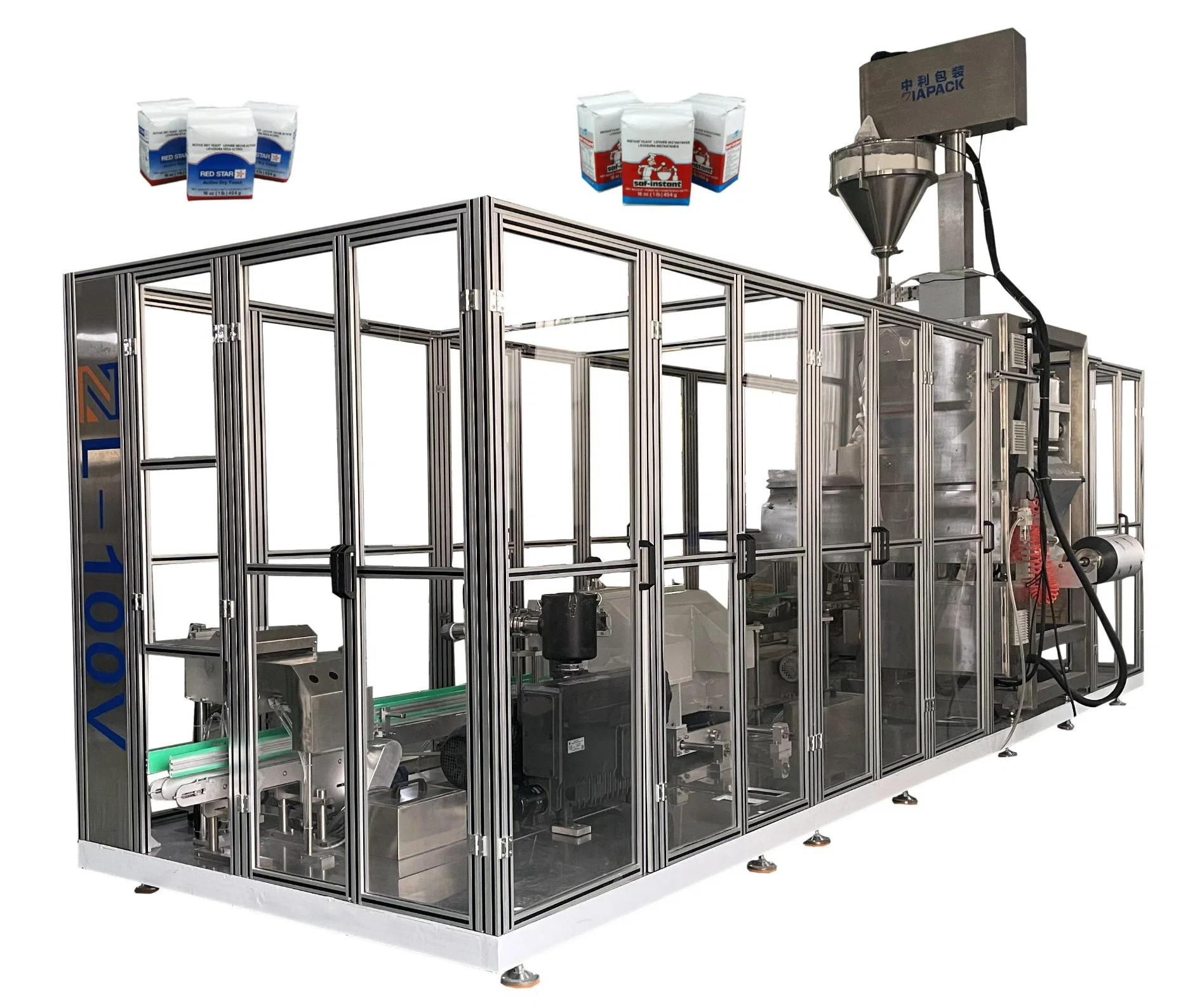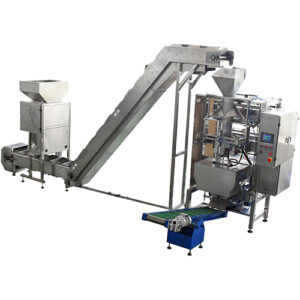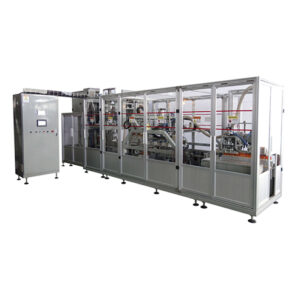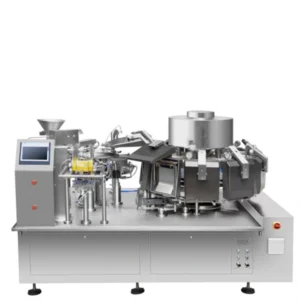Description
| Parameter | Specification |
|---|---|
| Machine Model | AVP-2000 |
| Application | Coffee powder, yeast |
| Packaging Type | Vacuum packaging |
| Speed | Up to 120 packs per minute (depending on product and settings) |
| Bag Types Supported | Pillow bags, gusseted bags, quad seal bags, etc. |
| Bag Dimensions | Length: 80mm – 300mm<br> Width: 80mm – 200mm |
| Filling Range | 5g – 1000g (adjustable) |
| Power Supply | 220V/50Hz or 380V/60Hz, 3 phase |
| Power Consumption | 6 kW |
| Air Pressure | 0.6 MPa (87 psi) |
| Air Consumption | 0.6 m³/min (21 CFM) |
| Machine Weight | 1500 kg |
| Machine Dimensions (LxWxH) | 2200mm x 1800mm x 2000mm |
| Material | Stainless Steel 304 |
| Control System | PLC (Programmable Logic Controller) |
| Touchscreen Interface | 12-inch color touchscreen |
| Vacuum Level | Adjustable, up to 99% vacuum |
| Sealing Type | Heat sealing or vacuum sealing |
| Packaging Material | Laminated films (PET/PE, PET/AL/PE, etc.) |
| Safety Features | Emergency stop button, safety sensors, guardrails |
| Optional Features | Date coding, nitrogen flushing, gas flushing, etc. |
In food production, packaging plays a significant role in quality preservation, product shelf life, and customer satisfaction. To meet the needs of customers today and enhance product integrity, traditional ways of packing are quickly being substituted with improved technology. An example is an automatic vacuum packing machine that was specifically designed for coffee powder and yeast. In this exhaustive article, we delve into the working processes, applications, functions benefits, and merits of these machines as they play central roles in the food and beverage industry.
Working Processes
Automatic vacuum packaging machines are complicated apparatuses that have been engineered to pack various products including coffee powder and yeast with accuracy and speed. The following working processes occur in these machines:
Product Loading: This step requires putting the product such as yeast or coffee powder into the specified area within the machine which will do all the packaging.
Bag Placement: The next step involves placing the packaging material which is usually in the form of pre-formed bags or pouches in a position where it can receive what is being packed.
Vacuum Sealing: When both the product to be packed and its package are inside, the machine starts up the process of vacuum sealing where air from inside is removed leaving behind a vacuum environment that safeguards freshness plus content quality.
Heat Sealing: Immediately after creating a vacuum, the packing materials get sealed by heat to prevent any possible entry of air onto those packages.
Cutting and Discharge: Lastly, vacuum-sealed packages packet out while also discharging them for distribution purposes wherever necessary.
Applications
The versatility of automatic vacuum packaging machines makes them indispensable across diverse industries with specific applications within the food & beverages sector. Some common areas include:
Coffee Industry: In the coffee industry, there are many automatic vacuum packaging machines used to pack grounded coffee powder, and whole beans among others like coffee pods. The vacuum-sealed packs help retain coffee’s aroma and flavor thus extending its shelf life besides keeping it fresh.
Yeast Production: In the manufacturing of yeast for baking and fermentation, mainly these machines are used to package powdered or granular yeast. Vacuum packaging makes sure that the yeast remains viable and active hence suitable for both culinary and industrial uses.
Food Preservation: Automatic vacuum packaging machines are not only used in packing coffee and yeast but also other types of foodstuffs such as meat, cheese, fruits, and vegetables among others. The shelf-life of perishable goods can be prolonged using vacuum-sealed packages since no bacterial growth or oxidation will take place in them.
Medical and Pharmaceutical Industries: The medical and pharmaceutical sectors use these machines to pack sensitive items like medicines, vaccines, or medical devices. To maintain product safety and integrity, vacuum sealing is critical in ensuring efficacy as well as sterility of contents.
Functions
Automatic vacuum packaging machines have a variety of functions that suit the different industries and products they serve. Important functions include:
Vacuum Sealing: Their central role is to create a vacuum in the package so that air is evacuated from it before sealing it off to preserve freshness & quality.
Heat Sealing: Closure to ensure air-tightness has been sealed with heat so that no contaminant or air can infiltrate into such content areas thereby interfering with them.
Product Weighing and Filling: A good number of automatic vacuum packaging machines come complete with integrated weighing as well as filling systems to enable them to dispense the required amount of product into every package correctly.
Gas Flushing: In some instances, for example in coffee bean packaging, gas flushing may be used to substitute air in the package with inert gases such as nitrogen that further prolongs the life of the product.
Multiple Packaging Formats: Some of these machines can host a variety of packaging formats like bags, pouches, or sachets making it possible for flexible design and size of packages.
Benefits
The use of automatic vacuum packing machines is advantageous to manufacturers, retailers, and consumers alike:
Extended Shelf Life: Vacuum packing helps elongate a product’s shelf-life by decreasing its exposure to oxygen, moisture, and other factors causing spoilage.
Preserving Freshness: By sucking out the air from within a package, Vacuum sealing contributes toward maintaining freshness, aroma, or flavor inside while offering consumers an excellent experience with final products.
Enhanced Quality Standards: This type of packaging helps protect contents against oxidation, loss of moisture, and contamination thus ensuring quality control over them.
Improved Product Presentation: On retail shelves, vacuum-sealed packages look professional and impressive thereby giving a higher value perception towards these products.
Increased Efficiency: Automatic vacuum packaging machines streamline the process cutting down labor cost inefficiencies hence optimizing production speed.
Reduced Food Waste: By extending perishable foodstuff shelf lives, this mechanism cuts both manufacturing and consumer food waste significantly.
Roles and Advantages
Automatic vacuum packaging machines are used in several ways in the food processing industry. They include:
Quality Assurance: These machines perform an important role in quality control and safety checks during packing processes reducing risks associated with spoilage as well as contamination or returns due to faulty products.
Market Competitiveness: Manufacturers who use this technology become competitive by producing high-quality products that last long on market shelves before losing their freshness completely.
Cost Saving: Despite the initial costs, low wastage of products, better efficiency, and improved presentation make these packaging machines cheaper in the long run.
Product Differentiation: Vacuum-sealed packaging signals quality to consumers setting apart commodities from other brands.
Consumer Confidence: They have a predictable consistency that builds trust among users thus leading to customer loyalty.
Environmental Sustainability: By reducing food waste and extending product shelf life, automatic vacuum packaging machines are contributing to environmental sustainability by minimizing resource utilization and landfill capacity.
FAQs
How does vacuum packaging extend the shelf-life of coffee powder and yeast?
By eliminating air from within the package, vacuum packing reduces oxidation as well as moisture contact which are the main causes of spoilage of the goods concerned.
Is it possible to pack different sizes or formats using a vacuum packing machine?
Yes, there are many types of automatic vacuum packaging machines available today and they can accommodate different sizes or formats for optimal flexibility during production runs.
Do vacuum-sealed packages preserve food quality over time?
Absolutely! These kinds of packs retain products’ freshness longer than any other form of storage.
Which products can be packed using Automatic Vacuum Packaging Machines (VPMs)?
These devices can be used with a very wide range of items like coffee powder, yeast, meat, cheese, fruits & vegetables medical supplies, etc.
Are special skills required for operating such systems?
Nevertheless, modern vacuum packaging machines are user-friendly and designed, and they come with extensive training aids for users although some familiarity with operating such a machine is essential.
Must gas be flushed into all vacuum-packed products?
Gas flushing for vacuum packing is an option as it depends on the needs of the product to be packaged. Mostly it’s used in products like coffee beans that need to stay fresh longer.
What kind of maintenance do automatic vacuum packaging machines require?
Regular maintenance activities like cleaning, lubrication, and component checkups are vital in making sure that the optimal performance and durability of this machine are well taken care of.
Can Existing Production Lines Accommodate Vacuum Packaging Machines?
Yes, already installed production units can accommodate automated vacuum sealing devices that improve efficiency through perfect integration.
What energy implications are there when using vacuum packaging machines?
Though these machines consume power while working, their energy-efficient nature as well as their decrease in food wastage rates have made them more sustainable overall.
Are Vacuum Sealed Packages Recyclable?
This will depend on the materials used to make the packages airtight. Most of the materials utilized for packing are recyclable; nonetheless, it is important to refer to local recycling guidelines when disposing of them.





